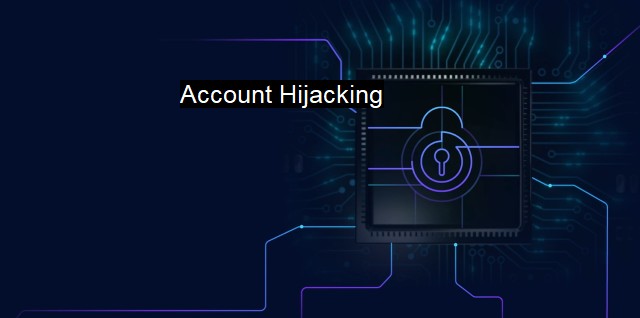What is Account Hijacking?
Account Hijacking: Understanding the Threat of Cyber Attacks on Personal and Business Accounts
Account hijacking is a crucial concept within the field of cybersecurity and the efforts involved in antivirus protections. It refers to the malicious, unauthorized infiltration of one's personal or professional digital accounts by an external entity intending harm for either financial gain or to disrupt normal functionality. Attackers may consequently compromise integrity, confidentiality, and availability while seizing these databases illegally.Impersonation, fraud, identity theft, data tampering, and system failure may result due to account hijacking. Among the accessible sequence for wrongful players are financial transactions digitally carried out by banks, internet service providers, and a landscape that especially enhances vulnerability, social media platforms which pool in the minutest personal details. Privacy and security provisions successfully placed are threatened, making robust and advanced measures the definite demand of the hour to prevent instances of account hijacking.
Account hijacking becomes successful largely due to two types of vulnerable situations: lack of effective cybersecurity norms and the unwary exposure from users' lapses in maintaining secure dictations properly. Cyber attackers exploit gullible users owing to common weaknesses like password misuse, unsecured internet connections, abandoned website sessions, using easy-to-guess security questions, unsophisticated phishing provocations and dishonest software applications. A typical tactic is to manipulate permissions to directories and credentials indifferently protected to seize critical resources.
To hijack an account, cyber criminals frequently rely on malware, a sort of malicious software that attacks a user's computer, mobile phone or tablet by disguising itself as a legitimate application. Frequently, this malware intrudes on the victim's system through downloadable files, misleading links in emails, or infected advertisements. During the process, personal, professional and financial details are withdrawn stealthily by the malware or indirectly provoked through counterfeited situations, hence unlawfully securing user accounts and their assets.
Account hijacking couldn't remain as a stealthy feature for long; lawmakers around the world are playing catch-up and drawing stringent policies while cybersecurity Watson contingents continuously manage counterattacks. That in no way simplifies hacking humongously; competences multiply drastically with advances in programming languages and devices exponentially multiplying yearly, if not monthly.
The best preventive measures, preventing an account from being taken over in this manner, stem from wholistic practices assimilated immaculately into known components integrating users and internet apparatus. Strengthening passwords or changing them regularly, adopting two-factor verification methods, conducting regular system updates and other precautionary features sharply reduce actionable surfaces for cyber intruders.
Tech giants investing in advanced API strategies or bot-security networks wipe out most fraudulent processes trying to wrongfully tower databases of information while maintaining credibility around private requirements such as financial transactions or social networking accounts, only to realise later that their efforts are continuously expanded upon by newer waves of account robbery cyberattackers with increased sophistication.
Increasing awareness levels among the users will indeed reduce these frequent functional challenges cropping up from tactics staged by illicit cyber scouts. Proficient and unified actions from security systems, governmental establishments, frequent consultations or advice tools primarily created for the elderly and distressed demographic will confront these unpleasant circumstances, yet the panacea needs to widen the spectrum across every value chain integrating digital dispositions of the concerned stakeholders.
Account hijacking falls assertively within the spectrum of cybersecurity, dictating the imperative need for adequate antivirus entailment. Adopting advanced,-mindful perceptions as concerted narratives concerning solidity across pursuits make structural security a realistically achievable proposition for all, consolidating a safer digital environment that renders substantial freedoms allowing committed productivity. The future seems undeniably promising that evolves beyond account hijacking’s negatively rooted realisations. Factors unifying integrity will stringently root hijackings in reports concluded long back, hopefully allowing digital pursuits enhanced cooperative syntheses allowing logical fruitfulness.

Account Hijacking FAQs
What is account hijacking?
Account hijacking refers to the unauthorized takeover of an individual's account, usually accomplished by stealing login credentials such as usernames and passwords.How does account hijacking occur?
Account hijacking can occur due to various reasons such as weak passwords, phishing attacks, malware infections, or social engineering.What are the consequences of account hijacking?
Account hijacking can lead to identity theft, financial loss, reputational damage, and loss of sensitive data.How can I prevent account hijacking?
To prevent account hijacking, you should use strong and unique passwords, enable two-factor authentication, keep your software and antivirus up to date, avoid phishing scams, and be cautious when sharing personal information online.| | A | | | B | | | C | | | D | | | E | | | F | | | G | | | H | | | I | | | J | | | K | | | L | | | M | |
| | N | | | O | | | P | | | Q | | | R | | | S | | | T | | | U | | | V | | | W | | | X | | | Y | | | Z | |
| | 1 | | | 2 | | | 3 | | | 4 | | | 7 | | | 8 | | |||||||